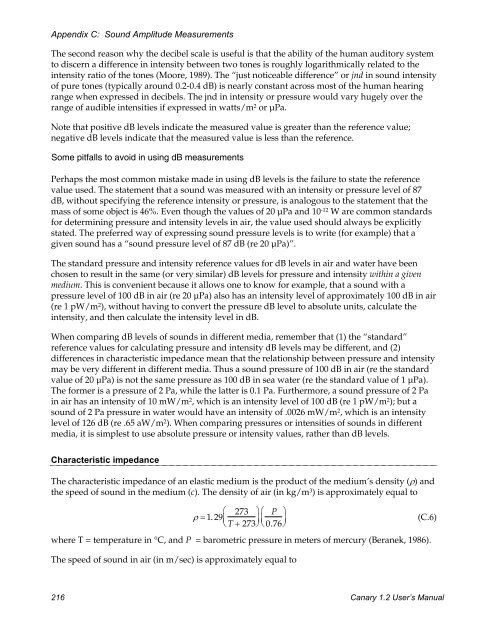User's Manual - Cornell Lab of Ornithology - Cornell University
User's Manual - Cornell Lab of Ornithology - Cornell University
User's Manual - Cornell Lab of Ornithology - Cornell University
Create successful ePaper yourself
Turn your PDF publications into a flip-book with our unique Google optimized e-Paper software.
Appendix C: Sound Amplitude MeasurementsThe second reason why the decibel scale is useful is that the ability <strong>of</strong> the human auditory systemto discern a difference in intensity between two tones is roughly logarithmically related to theintensity ratio <strong>of</strong> the tones (Moore, 1989). The “just noticeable difference” or jnd in sound intensity<strong>of</strong> pure tones (typically around 0.2-0.4 dB) is nearly constant across most <strong>of</strong> the human hearingrange when expressed in decibels. The jnd in intensity or pressure would vary hugely over therange <strong>of</strong> audible intensities if expressed in watts/m 2 or µPa.Note that positive dB levels indicate the measured value is greater than the reference value;negative dB levels indicate that the measured value is less than the reference.Some pitfalls to avoid in using dB measurementsPerhaps the most common mistake made in using dB levels is the failure to state the referencevalue used. The statement that a sound was measured with an intensity or pressure level <strong>of</strong> 87dB, without specifying the reference intensity or pressure, is analogous to the statement that themass <strong>of</strong> some object is 46%. Even though the values <strong>of</strong> 20 µPa and 10 -12 W are common standardsfor determining pressure and intensity levels in air, the value used should always be explicitlystated. The preferred way <strong>of</strong> expressing sound pressure levels is to write (for example) that agiven sound has a “sound pressure level <strong>of</strong> 87 dB (re 20 µPa)”.The standard pressure and intensity reference values for dB levels in air and water have beenchosen to result in the same (or very similar) dB levels for pressure and intensity within a givenmedium. This is convenient because it allows one to know for example, that a sound with apressure level <strong>of</strong> 100 dB in air (re 20 µPa) also has an intensity level <strong>of</strong> approximately 100 dB in air(re 1 pW/m 2 ), without having to convert the pressure dB level to absolute units, calculate theintensity, and then calculate the intensity level in dB.When comparing dB levels <strong>of</strong> sounds in different media, remember that (1) the “standard”reference values for calculating pressure and intensity dB levels may be different, and (2)differences in characteristic impedance mean that the relationship between pressure and intensitymay be very different in different media. Thus a sound pressure <strong>of</strong> 100 dB in air (re the standardvalue <strong>of</strong> 20 µPa) is not the same pressure as 100 dB in sea water (re the standard value <strong>of</strong> 1 µPa).The former is a pressure <strong>of</strong> 2 Pa, while the latter is 0.1 Pa. Furthermore, a sound pressure <strong>of</strong> 2 Pain air has an intensity <strong>of</strong> 10 mW/m 2 , which is an intensity level <strong>of</strong> 100 dB (re 1 pW/m 2 ); but asound <strong>of</strong> 2 Pa pressure in water would have an intensity <strong>of</strong> .0026 mW/m 2 , which is an intensitylevel <strong>of</strong> 126 dB (re .65 aW/m 2 ). When comparing pressures or intensities <strong>of</strong> sounds in differentmedia, it is simplest to use absolute pressure or intensity values, rather than dB levels.Characteristic impedanceThe characteristic impedance <strong>of</strong> an elastic medium is the product <strong>of</strong> the medium’s density (ρ) andthe speed <strong>of</strong> sound in the medium (c). The density <strong>of</strong> air (in kg/m 3 ) is approximately equal to⎛ 273 ⎞ ⎛ P ⎞ρ = 1. 29⎜⎟ ⎜ ⎟⎝ T + 273⎠⎝ 0.76⎠where T = temperature in °C, and P = barometric pressure in meters <strong>of</strong> mercury (Beranek, 1986).The speed <strong>of</strong> sound in air (in m/sec) is approximately equal to(C.6)216 Canary 1.2 User’s <strong>Manual</strong>
















